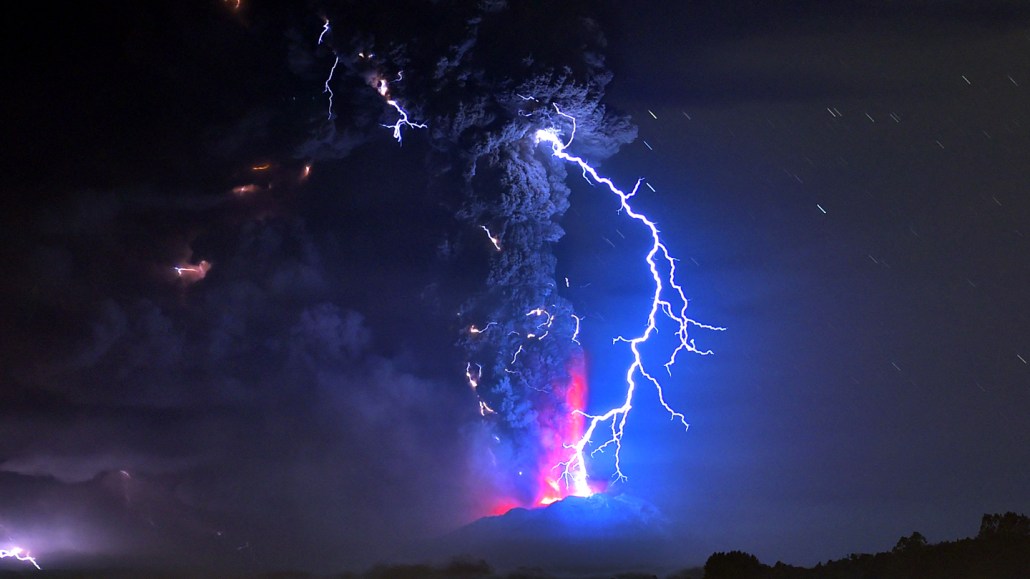
Volcanic eruptions can generate lots of lightning. Those strikes split nitrogen molecules in the air, allowing nitrogen atoms to react with other elements to make compounds that living organisms can use.
MARTIN BERNETTI/AFP via Getty Images
Millions of years ago, giant volcanic eruptions in what’s now Turkey and Peru each deposited millions of metric tons of nitrate on the surrounding land. That nutrient may have come from volcanic lightning, researchers reported April 24 at a meeting of the European Geosciences Union in Vienna.
The discovery adds evidence to the idea that, early in Earth’s history, volcanoes could have provided some of the materials that made it possible for life to emerge, says volcanologist Erwan Martin of Sorbonne University in Paris.
Nitrogen is an essential ingredient in biological molecules, such as proteins and DNA. It makes up about 78 percent of the atmosphere. But nitrogen molecules in the air consist of two tightly bound nitrogen atoms. Only when these atoms are separated will they react with other elements and create forms of nitrogen useful to life, such as nitrate (SN: 4/8/08).
Some microbes can tease apart the nitrogen molecules and provide “fixed nitrogen” to plants and fungi. Human chemists can do it too, creating fertilizer. But before life could start, some nonbiological process must have been at play.
Lightning is the obvious candidate, Martin says. These extremely energetic electric discharges can tear apart nitrogen atoms, which will combine with oxygen to form nitrogen oxides and eventually nitrate.
The lightning in thunderstorms, brought about by ice particles colliding and charging, separates nitrogen molecules every day, but at low rates and spread out over large areas. Volcanic plumes, in which dust particles do the colliding and charging, can provide localized lightning at staggering intensities. During one day of the 2022 eruption of the Hunga Tonga-Hunga Ha’apai volcano in Indonesia, for instance, there were about 400,000 discharges (SN: 12/13/22).
Even that large amount of lightning creates a relatively small amount of nitrate. But rare, huge eruptions, of the kind that happen only every 100,000 years or so, could create much more. The idea that such events could produce and deposit a lot of nitrate is not new, Martin says, but until now nobody had actually looked at the nitrogen content of volcanic deposits from these eruptions.
His group sampled outcrops in Turkey and Peru linked to 10 explosive eruptions that happened between 20 million and 1 million years ago. Their locations’ relatively dry climate helps ensure that any nitrate formed long ago, which is soluble in water, would not have all leached out by now.
The nitrate that the researchers found turns out to contain oxygen atoms with different masses, in a proportion similar to that of the three oxygen atoms that make up each molecule of ozone in the air. This shows that the nitrates were formed in the atmosphere and not by some process on the ground, the team says.
Based on their sampling, the researchers estimate that each eruption on average deposited about 60 million tons of nitrate.
Life may have begun roughly 3.7 billion years ago, long before the eruptions that Martin and colleagues studied (SN: 3/1/17). But Earth’s early years were full of such extreme volcanism. Some researchers think that lightning over volcanic islands, in particular, played a role in the emergence of life, before even the continents were fully formed. On the young Earth, Martin says, similar amounts of nitrate as those estimated in the new study could have been produced on such islands, long since submerged.
The study’s concept is interesting, says marine chemist Jeffrey Bada of the Scripps Institution of Oceanography in La Jolla, Calif. But he thinks the researchers should have addressed the different composition of the atmosphere at the time that life first came on the scene.
“In today’s world, lightning on volcanic islands produces copious amounts of nitrogen oxides,” Bada says. “But in the early Earth, when the atmosphere had little oxygen in it, the product would have been probably ammonia.” Like nitrate, ammonia is a form of nitrogen that’s biologically usable.
But, Martin says, in a volcanic plume, there is a lot of water and other oxygen compounds coming from the magma, which could have supplied some of that oxygen. And in those early days, he says, “maybe it wasn’t nitrate but ammonia — it’s still nitrogen available for life. These are still things that need to be studied.”






